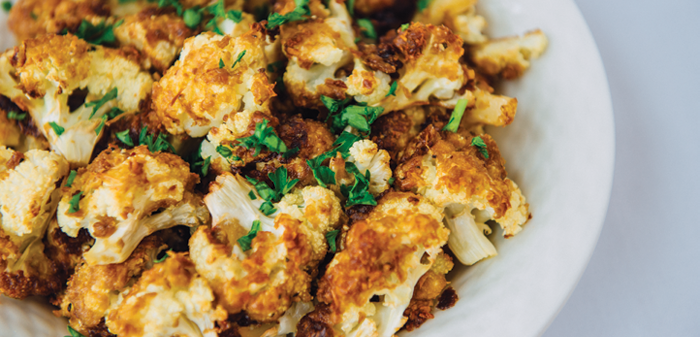
Diet: Gluten-Free, Vegetarian, Dairy Free, Vegan
Cauliflower is a mild cruciferous vegetable that people have eaten for at least 2,000 years. Cruciferous vegetables include cabbages, broccoli, kale, turnips, Brussels sprouts, plus many more vegetables that are plentiful from our local farms. Cauliflower “heads” can be white, purple or dark yellow in color. The florets are the part that most people eat however, the stem and leaves are edible too. Cruciferous vegetables contain antioxidants that protect body cells from damage caused by exposure to free radicals, which are considered a significant factor in aging and heart disease, diabetes and cancer. When consumed, you are taking in a combination of vitamins A, B, C and K as well as calcium and other minerals. There is also plenty of fiber that helps to keep your digestive system healthy.
Nutritional yeast is a healthy vegan alternative to Parmesan cheese, as it holds a nutty flavor that lends itself well to everything from pasta to popcorn. It is an inactive yeast grown primarily for nutritional purposes. It is high in protein and rich in B vitamins, including B-12, that are important for normal and healthy body functions. In this recipe it works to coat cauliflower, which is then roasted and transformed into a decadent yet healthy snack or side dish.
Ingredients
- 1 large head of cauliflower (about 4 heaping cups)
- ½ cup nutritional yeast
- ½ teaspoon garlic powder
- ¼ teaspoon ground black pepper
- ¼ teaspoon salt
- ¼ cup olive oil
- Parsley, for garnish, optional
Directions
-
Preheat oven to 400°F. Line a large baking sheet with aluminum foil.
-
Cut cauliflower into bite-sized florets.
-
In a medium bowl, combine nutritional yeast, garlic powder, pepper and salt.
-
Pour oil into a small bowl.
-
Lightly dip each floret into oil* and then dip into nutritional yeast mixture to coat. Place on baking sheet and repeat with each floret.
-
Bake 45 to 60 minutes, until browned. Top with a handful of chopped parsley (if using) and serve immediately.
Recipe Notes
*Cauliflower should be lightly coated in oil, not saturated, so avoid submerging it into the bowl.
